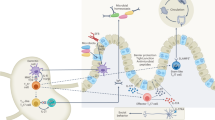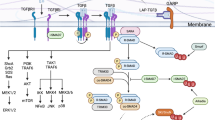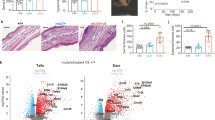Abstract
The autosomal dominant hyper-IgE syndrome (HIES, ‘Job’s syndrome’) is characterized by recurrent and often severe pulmonary infections, pneumatoceles, eczema, staphylococcal abscesses, mucocutaneous candidiasis, and abnormalities of bone and connective tissue1,2. Mutations presumed to underlie HIES have recently been identified in stat3, the gene encoding STAT3 (signal transducer and activator of transcription 3) (refs 3, 4). Although impaired production of interferon-γ and tumour-necrosis factor by T cells5, diminished memory T-cell populations, decreased delayed-type-hypersensitivity responses and decreased in vitro lymphoproliferation in response to specific antigens6 have variably been described, specific immunological abnormalities that can explain the unique susceptibility to particular infections seen in HIES have not yet been defined. Here we show that interleukin (IL)-17 production by T cells is absent in HIES individuals. We observed that ex vivo T cells from subjects with HIES failed to produce IL-17, but not IL-2, tumour-necrosis factor or interferon-γ, on mitogenic stimulation with staphylococcal enterotoxin B or on antigenic stimulation with Candida albicans or streptokinase. Purified naive T cells were unable to differentiate into IL-17-producing (TH17) T helper cells in vitro and had lower expression of retinoid-related orphan receptor (ROR)-γt, which is consistent with a crucial role for STAT3 signalling in the generation of TH17 cells7,8,9,10,11,12,13,14. TH17 cells have emerged as an important subset of helper T cells15 that are believed to be critical in the clearance of fungal16 and extracellular bacterial17 infections. Thus, our data suggest that the inability to produce TH17 cells is a mechanism underlying the susceptibility to the recurrent infections commonly seen in HIES.
This is a preview of subscription content, access via your institution
Access options
Subscribe to this journal
Receive 51 print issues and online access
$199.00 per year
only $3.90 per issue
Buy this article
- Purchase on Springer Link
- Instant access to full article PDF
Prices may be subject to local taxes which are calculated during checkout



Similar content being viewed by others
References
Buckley, R. H., Wray, B. B. & Belmaker, E. Z. Extreme hyperimmunoglobulinemia E and undue susceptibility to infection. Pediatrics 49, 59–70 (1972)
Grimbacher, B. et al. Hyper-IgE syndrome with recurrent infections—an autosomal dominant multisystem disorder. N. Engl. J. Med. 340, 692–702 (1999)
Minegishi, Y. et al. Dominant-negative mutations in the DNA-binding domain of STAT3 cause hyper-IgE syndrome. Nature 448, 1058–1062 (2007)
Holland, S. M. et al. STAT3 mutations in the Hyper-IgE syndrome. N. Engl. J. Med. 357, 1608–1619 (2007)
Del Prete, G. et al. Defective in vitro production of γ-interferon and tumor necrosis factor-α by circulating T cells from patients with the hyper-immunoglobulin E syndrome. J. Clin. Invest. 84, 1830–1835 (1989)
Buckley, R. H. The hyper-IgE syndrome. Clin. Rev. Allergy Immunol. 20, 139–154 (2001)
Acosta-Rodriguez, E. V., Napolitani, G., Lanzavecchia, A. & Sallusto, F. Interleukins 1β and 6 but not transforming growth factor-β are essential for the differentiation of interleukin 17-producing human T helper cells. Nature Immunol. 8, 942–949 (2007)
Korn, T. et al. IL-21 initiates an alternative pathway to induce proinflammatory TH17 cells. Nature 448, 484–487 (2007)
Nurieva, R. et al. Essential autocrine regulation by IL-21 in the generation of inflammatory T cells. Nature 448, 480–483 (2007)
Wilson, N. J. et al. Development, cytokine profile and function of human interleukin 17-producing helper T cells. Nature Immunol. 8, 950–957 (2007)
Yang, X. O. et al. STAT3 regulates cytokine-mediated generation of inflammatory helper T cells. J. Biol. Chem. 282, 9358–9363 (2007)
Chen, Z. et al. Selective regulatory function of Socs3 in the formation of IL-17-secreting T cells. Proc. Natl Acad. Sci. USA 103, 8137–8142 (2006)
Laurence, A. et al. Interleukin-2 signaling via STAT5 constrains T helper 17 cell generation. Immunity 26, 371–381 (2007)
Mathur, A. N. et al. Stat3 and Stat4 direct development of IL-17-secreting Th cells. J. Immunol. 178, 4901–4907 (2007)
Steinman, L. A brief history of T(H)17, the first major revision in the TH1/TH2 hypothesis of T cell-mediated tissue damage. Nature Med. 13, 139–145 (2007)
Huang, W., Na, L., Fidel, P. L. & Schwarzenberger, P. Requirement of interleukin-17A for systemic anti-Candida albicans host defense in mice. J. Infect. Dis. 190, 624–631 (2004)
Happel, K. I. et al. Divergent roles of IL-23 and IL-12 in host defense against Klebsiella pneumoniae. J. Exp. Med. 202, 761–769 (2005)
Wolk, K. & Sabat, R. Interleukin-22: a novel T- and NK-cell derived cytokine that regulates the biology of tissue cells. Cytokine Growth Factor Rev. 17, 367–380 (2006)
Tanaka, T. et al. Distinct gene expression patterns of peripheral blood cells in hyper-IgE syndrome. Clin. Exp. Immunol. 140, 524–531 (2005)
Kao, C. Y. et al. IL-17 markedly up-regulates β-defensin-2 expression in human airway epithelium via JAK and NF-κB signaling pathways. J. Immunol. 173, 3482–3491 (2004)
Ye, P. et al. Requirement of interleukin 17 receptor signaling for lung CXC chemokine and granulocyte colony-stimulating factor expression, neutrophil recruitment, and host defense. J. Exp. Med. 194, 519–527 (2001)
Miller, L. S. et al. MyD88 mediates neutrophil recruitment initiated by IL-1R but not TLR2 activation in immunity against Staphylococcus aureus. Immunity 24, 79–91 (2006)
Schnyder-Candrian, S. et al. Interleukin-17 is a negative regulator of established allergic asthma. J. Exp. Med. 203, 2715–2725 (2006)
Ozaki, K. et al. A critical role for IL-21 in regulating immunoglobulin production. Science 298, 1630–1634 (2002)
Pesce, J. et al. The IL-21 receptor augments Th2 effector function and alternative macrophage activation. J. Clin. Invest. 116, 2044–2055 (2006)
Kuchen, S. et al. Essential role of IL-21 in B cell activation, expansion, and plasma cell generation during CD4+ T cell–B cell collaboration. J. Immunol. 179, 5886–5896 (2007)
King, C. L. et al. Frequency analysis of IgE-secreting B lymphocytes in persons with normal or elevated serum IgE levels. J. Immunol. 146, 1478–1483 (1991)
Mucida, D. et al. Reciprocal TH17 and regulatory T cell differentiation mediated by retinoic acid. Science 317, 256–260 (2007)
Pitcher, C. J. et al. HIV-1-specific CD4+ T cells are detectable in most individuals with active HIV-1 infection, but decline with prolonged viral suppression. Nature Med. 5, 518–525 (1999)
Grimbacher, B. et al. Genetic linkage of hyper-IgE syndrome to chromosome 4. Am. J. Hum. Genet. 65, 735–744 (1999)
Acknowledgements
This work was supported by the intramural program of the National Institutes of Health.
Author Contributions J.D.M., J.M.B., A.L., B.J.H., K.M.E., Y.K., A.H., H.Z.E., M.L.P. and A.I.A. performed experiments and analysed data. A.F.F., C.S., J.D. and S.M.H. evaluated patients and obtained samples. J.D.M., J.M.B., A.L., J.O’S., S.M.H., W.E.P. and D.C.D. conceived the study, designed experiments, interpreted data and wrote the manuscript.
Author information
Authors and Affiliations
Corresponding author
Supplementary information
Supplementary Information
The file contains Supplementary Figures 1-4 with Legends. (PDF 837 kb)
Rights and permissions
About this article
Cite this article
Milner, J., Brenchley, J., Laurence, A. et al. Impaired TH17 cell differentiation in subjects with autosomal dominant hyper-IgE syndrome. Nature 452, 773–776 (2008). https://doi.org/10.1038/nature06764
Received:
Accepted:
Published:
Issue Date:
DOI: https://doi.org/10.1038/nature06764
This article is cited by
-
Isolated Chronic Mucocutaneous Candidiasis due to a Novel Duplication Variant of IL17RC
Journal of Clinical Immunology (2024)
-
Non-superficial Cutaneous Manifestations by Candida Species
Current Fungal Infection Reports (2024)
-
Interventional pulmonary procedures and their outcomes in patients with STAT3 hyper IgE syndrome
BMC Surgery (2023)
-
Toxin expression during Staphylococcus aureus infection imprints host immunity to inhibit vaccine efficacy
npj Vaccines (2023)
-
Extrathymic expression of Aire controls the induction of effective TH17 cell-mediated immune response to Candida albicans
Nature Immunology (2022)
Comments
By submitting a comment you agree to abide by our Terms and Community Guidelines. If you find something abusive or that does not comply with our terms or guidelines please flag it as inappropriate.



